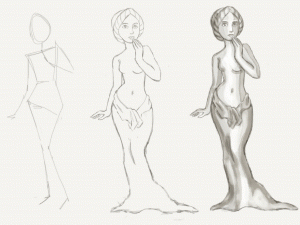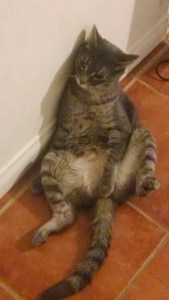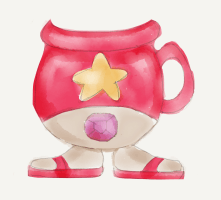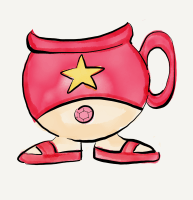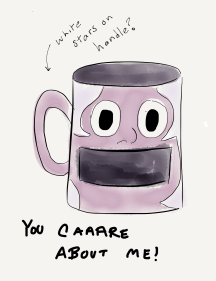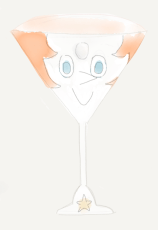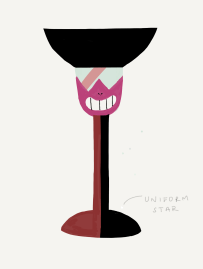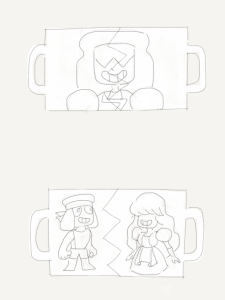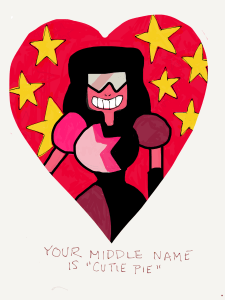Rachel Swirsky's Blog, page 24
April 7, 2016
I’m not that interested in footwear.
Originally published at Rachel Swirsky. You can comment here or there.
But I really enjoyed playing with these textures.
Stylus, pictionary program.
Speaking of which, this chart seems really useful for writing about characters’ fashion:
(from pinterest, which claims it’s from buzzfeed)
April 6, 2016
Nine tenths of the Law
Originally published at Rachel Swirsky. You can comment here or there.
My cats have stolen my backpack.
Their nefarious plan is to cover it with enough fur that it will scoff at the lint brush. (They will succeed.)
April 5, 2016
Silly Interview with Fran Wilde, expert on man-made wings
Originally published at Rachel Swirsky. You can comment here or there.
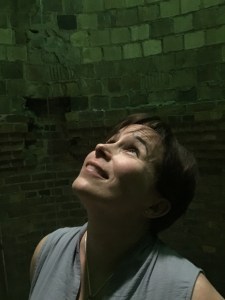 Thank you to Fran Wilde for agreeing to do a silly interview!
Thank you to Fran Wilde for agreeing to do a silly interview!
I met Fran a few years ago at WorldCon, but we really got some nice time together at 2015’s ICFA in the pool. Later, we discussed migraine glasses.
Fran’s first novel, Updraft, is a Nebula nominee. She has another novel coming out in 2016 (Cloudbound) and a Tor.com novella (The Jewel and Her Lapirdary) out in May. She’s published short stories in some of the usual suspects like Asimovs, Tor and Nature.
1. Like a million writers before you, you’ve had to deal with being a primary caregiver (yes?) and writing. What are your strategies?
I’m a parent and a trailing spouse (ie: spouse gets job, you move [which? I never thought I’d be doing that!]), and I occasionally need to look in on my parents. I’m also a freelancer. That makes for a lot of “Stop everything you are doing / thinking about / concentrating on and focus on this other thing right now!” which isn’t particularly conducive to a calm writing environment. My solution for a long time was stops-and-starts, which wasn’t really a solution because I rarely finished anything. Then I started scheduling my writing like I would a job or another task, on the theory that if I didn’t put it first, no one would. Even if it meant getting up before everyone else (and I am a TERRIBLE morning person), even if it was just for an hour or two. Writing is the thing I do first now. That doesn’t mean I neglect the other things, and it’s still a lot of work finding an hour, or day here, another there, but especially as my family has evolved, tasks are getting easier to distribute… and we’re getting much better at all communicating our needs to each other instead of assuming that someone will always be there to catch what needs caught, or that this need or that need isn’t as important as someone else’s. (And we make a lot of lists and spreadsheets and schedule as much as we can in advance. That sometimes still doesn’t work out, though!)
I think, actually, the hardest thing for a long time was the isolation. Not being able to get out to coffee shops, or even knowing that writers’ groups, or writing retreats / workshops existed, made it hard to see myself doing what I loved as a valid choice. It’s always easier to say “this person needs me to do x, then y, before I can think of doing my own work.” It felt selfish to do anything else. Especially when there wasn’t anyone nearby to point to as another way to do things. When I figured out that I could say “I am taking these two hours to write,” or “I’d like to go for this weekend retreat,” and everyone would see if they could make room for that — willingly! — that was an enormous change. And by doing that, I was able to connect with other writers — both in person and by Google chat, which is huge, because even if I can’t get out to something, being able to connect online makes all the difference.
These days, sometimes the timespan I need is a lot more than two hours, and sometimes it’s weirdly hard having my focus broken when someone needs something right that minute that I haven’t planned for. And sometimes I still need reassurance that what I’m doing has value to the family / to me / to others. But we’re getting there.
2. The setting for UPDRAFT is very unusual–it contains a mosaic of different elements that aren’t usually associated with each other. How did you develop such a layered world?
Mostly I developed the world through layering. The bone towers have been there from the start, as have the wings, the clouds, and some of the characters. But the rest came from asking questions about what would be the logical extension of a sky-bound culture — what would they lack, what would they not know they were lacking? What physical features of the landscape impacted politics? How would that change over time? I’d add those layers in, write side stories about various groups and events that happened far from the events of the novel, and let those events quietly impact the rest of the world. And then I’d go back and do another layer.
3. Have you ever done skydiving or hang gliding or anything similar?
I haven’t! I’m a sailor. I have relatives who hang-glide, and I spent a lot of my childhood watching storms roll in on the cliffs of the Chesapeake Bay (it gets really windy), but in order to do the research for UPDRAFT, I wanted to feel the physics of being in a wind tunnel, and I wanted to make sure I was writing a flying book, not a sailing book turned sideways. So I went indoor skydiving, which was a hoot. And very spinny.
The wings in the book aren’t hang-gliding wings, they’re more like a cross between furlable wings and wing-suit wings, so I also watched a lot of wingsuit fliers on long-flights and also doing particularly dangerous things like flying through canyons. I researched about 2,000 years of man-made wings in history, and talked a lot with engineers who understand the physics of foils – aka: wings.
3a. Bonus question! What were the most unexpected things you learned about man-made wings?
The number of times a version of “but forgot to add a way to lift their feet and so broke both legs in the fall” appeared in the texts. Repeatedly.
This stained glass window in Malmesbury (link), depicting Eilmer – an 11th Century monk who tried to fly. (And who forgot to lift his feet and/or panicked and broke both legs in the fall.)
The reported 17th c. Khan’s reaction to Ottoman-empire polymath Hezârfen Ahmet Çelebi *successful* flight over a body of water : a sack of gold coins, while stating “This is a scary man, he is capable of doing anything he wishes.” Plus exile to Algeria.
4. We both deal with migraines that interfere in our lives in all sorts of inconvenient ways–when we should be writing, when we should be on panels at conventions, to name only a couple that relate to writing. Actually, I don’t think I have a question here. I’m just complaining. Why don’t you complain some, too.
Ugh, yeah. My usual thought when I feel a migraine coming is: “Maybe it won’t be that bad?” or “I can get through this task, then go take care of myself. Maybe it won’t be that bad.” Hah. No. Bad idea. I hate putting people out, or causing a stir, and I am really bad at asking for help, so sometimes I’ll push myself even harder to work through it, and of course the migraine always pushes back, often at the WORST times. That said, once I figured out most of my migraine accelerants, I’ve been able to control them more. That’s been really good, except when it’s not. Grumble.
Ok, tossing this back at you! How do you deal with the unpredictability and the invisibility of migraines? How do you communicate pain to someone else when there are few visible markers until things are really really bad?
RS: Oo, throwing the question back at me. Meta. My migraines may not be as bad as yours; I’m often in a kind of demi-functioning, impaired-but-not-totally-gone state. So, I do things like go to meetings and just sit with my hands over my eyes, which I find most people are pretty good about even though it looks weird. I think the visual component makes it easy for most people to understand. These days, I actually have a medicine that works very reliably, but it makes it impossible for me to drive, so it’s inconvenient. And I often still fall asleep (my migraines usually put me to sleep). I don’t like having to bail on commitments when they happen. It’s deeply frustrating.
5. Back to me asking the questions! You’ve had a really fast career growth spurt in the past year. What’s the most unexpected thing you’ve encountered?
It’s funny – it doesn’t feel fast? There’s a lot of work that went on under the surface, both in the years before I was public about the fact that I was writing again, and in the years since I started sending out stories. And there’s also the feeling of “ok what is the next thing?” So I guess I feel like I’m always growing and learning, and that there are always going to be more elements of craft and practice that I want to hone.
Most unexpected was the realization that it doesn’t get easier. A friend told me once that it gets differently hard. She was right, but then she is almost always right.
6. Do you have any upcoming projects, or anything else you’d like to talk about? Entertaining lies are encouraged. (Non-entertaining lies are tolerated.)
My gem universe novella “The Jewel And Her Lapidary,” a hidden history wrapped in a traveler’s guide, is coming out in May from Tor.com. And CLOUDBOUND — a companion novel to Updraft (not a sequel!) comes out in September, which I’m really excited for.
I’m staffing Paradise Lost in May, and am a writer in residence at University of Richmond in March, as well as at York University in the fall.
I have some more research-based activities I’m planning, both for the last novel in the Updraft cycle, as well as for another completely unrelated project. And more gem universe stories. No spoilers though.
I can’t think of any entertaining lies! I should practice that. YES. My upcoming project will be boot-camp training in entertaining lies.
April 4, 2016
The difference between draft 1 and draft 12ish of “Love Is Never Still”
Originally published at Rachel Swirsky. You can comment here or there.
I thought it might be interesting to look at a passage from my most recent story, “Love Is Never Still,” as it existed in the first and last drafts. By the time I actually publish a story, I’ve often forgotten what the first draft looked like exactly.
Stages of drawing Galatea. Based on this painting.
When I sat down to write “Love Is Never Still,” I did it in one unrevised chunk, so I actually have the text I wrote as I wrote it. It is, as I sometimes warn my beta readers, “hot off the brain presses.”
Draft one:
The Sculptor
I should not have wished her living, that lithe creature whose limbs I had freed from their marble enclosures, whose rounds and slopes had shaped beneath my chisel. She was delicately colored, like the palest of women, and when I ran my hand across the plump of her arm, she was smooth and cold.
I thought that, if she were only flesh, we could embrace. I had wanted her that way through every moment of carving. When I put down the tools and regarded those around me, I saw scars and poxes, rotting teeth, and all the other innumerable perfections nature works on even the most fit bodies. I knew I was sculpting perfection that no woman could match who was borne through flesh and not through stone.
A man may design many things in his life—his home, his career, his presence in the world. Yet men are denied the greatest challenge of all, to create the embodiment of his desire.
With every chip, I imagined the woman she would be. Not only the striking features of her face, but the way she would see me, her literal maker, with awe and humility and measureless gratitude. I would be all to her, god and husband, as Zeus and Apollo and the others are to their mortal wives.
Galatea was flawless to my eye. And if, later, I discovered she was flawed, it was I who had to answer for it.
I prayed for her life, and Aphrodite granted it. They say the goddess of love is warm-hearted, but I have not found her to be kind.
Draft twelve of the first section (the draft which appears in Uncanny Magazine):
The Sculptor
Through every moment of carving, I want her as one wants a woman. I want this lithe creature whose limbs I’ve freed from their ivory enclosures, whose rounds and slopes are discovering their shapes beneath my chisel. She is delicately colored like the palest of women, and when I run my fingers across the plump of her arm, she is smooth and cold.
When necessity requires I set down my tools and leave my estate, all I see are marked bodies. Cooks and merchants, sailors and slaves, rich men and prostitutes—all wear scars and wrinkles and poxes and rotting teeth.
I am sculpting perfection no woman born from mortal flesh can match. I lift my hands to her bosom. Her ivory is soft beneath my palms. I fear I would bruise her if I pressed too eagerly.
Thoughts:
Draft 1 is surprisingly cogent, which is probably because this is the first section. The later stuff, written as I was getting fatigued, is likely much less coherent.
Also, the first couple paragraphs were originally a poem I was trying to write, so I did work on the words there (although they had line breaks in).
There are a lot of ideas in draft one and they bounce around too fast from one subject to another. I have a tendency to do this. It shows up especially in my poetry where I have trouble slowing down to unpack a single image. It shows up in my first prose drafts, too, and I have to put in some effort to bat it back. I remember what Marilynne Robinson told me: that it’s okay to be slow, and try to let each moment be itself.
Although it appears I cut a huge amount, I actually displaced a lot of it. The final draft has a version of the first two paragraphs from the original. The third, fifth, and sixth were shuffled down to later places in the story where they would work better. The only paragraph that went entirely is the fourth, in which the sculptor fantasizes about being godlike, because that wasn’t the character I eventually ended up writing. The sculptor who pictures himself as a god and Galatea as a supplicant is nakedly ambitious and exploitative in a way the sculptor in the story is not.
Related to the fact that I had a lot of ideas bouncing around, I note that the original draft is long on shiny abstract statements and short on images and movements. That’s why the paragraphs could be detached and placed elsewhere so easily. They are good emotional turns and character moments to steer the plot and pacing one way or another, but they need anchors so they don’t feel empty.
And related to both of those, the problem with the hodgepodge of abstract statements is that there’s no coherence to the narrative beneath them. Why does it flow from one paragraph to another in the way it does? The paragraphs aren’t connected terribly; I can see why one thought led to another while I was writing. But it’s better* when you can make the structure underneath a section like that a strong, moving force–something that goes in a straight line instead of circling itself, repeating incidents, themes, or arguments.
The main fix for all of this was to pare down the number of concepts I was trying to get across to just what needed to be in the first impression of the story–he is carving her, and he is obsessed with her. I gave it a through thread (“I want her, and this is why.”). Then I moved from the abstractions into a physical moment when he moves in to touch her. (The bruise thing is from Ovid – “he fears he then may bruise her by his eager pressing.”) That gives me a physical anchor for moving into Galatea’s point of view. Moving into her perspective so quickly also means that I immediately set up the rhythm of multiple points of view, and establish her perspective as being of equal importance to the sculptor’s.
There’s a lot of subtler linguistic stuff, cutting words–especially redundancies–and toning down a bit on drama, particularly by cutting that fourth paragraph (“awe and humility and measureless gratitude”–thanks, we get it.). And a lot of reorganizing. My essential philosophy is that prose can be complex and also feel (relatively) easy to read as long as you get it down so that it easily flows from one sentence and concept to the next. I reorganized this piece a *lot* as I revised, particularly because a major component of the revision was attempting to rebalance the strength of the Galatea and Aphrodite arcs.
April 1, 2016
Ceci n’est pas un April Fools Prank
Originally published at Rachel Swirsky. You can comment here or there.
This space intentionally left blank.
Friday Fiction Recommendation: “One Paper Airplane Graffito Love Note” by Will McIntosh
Originally published at Rachel Swirsky. You can comment here or there.
Will McIntosh is an exceptional writer whose work deserves more recognition than it gets. He won the Hugo Award several years ago for the excellent short story “Bridesicle,” but I wish people had paid more attention to his following novels and short stories. He does aliens really, really well.
However, this story has no aliens. It has dreamy magical realism instead.
“One Paper Airplane Graffito Love Note” by Will McIntosh:
A paper airplane drifted high in the sky above the field. I nearly crashed my bicycle, straining to follow its path as it circled above the treetops at the far edge. It held the wind beautifully, effortlessly. Pausing, it hovered over the field just as a seabird holds its position above crashing waves.
I slowed to a stop, feeling for the ground with one foot, afraid to take my eye off the craft lest I lose it in the clouds. Neck craned, eyes to the sky, I let the bicycle drop. I tracked the paper’s elegant flight, running this way and that like a boy as it slowly, slowly lost altitude.
As it made its final pass, it gained speed, careening across the field. I loped after it as it tumbled end-over-end and lay still.
I plucked it from the grass.
It was folded in a distinct design—squat and wide, with a hinged belly. It was covered in writing. I recognized Anna’s handwriting instantly, and that familiar ache that I both loved and hated coursed through me. I flipped the hinge and unfolded the airplane. It was a letter to me, though because it was a graffito confession, I wasn’t named.
The leaves outside my window rustle like dry paper. The cat, stalking prey in the yard, is a paper cat. The paperboy is a paper boy, the waning sun a lightbulb. I miss you. . . .
Fingers trembling, fighting tears, I put it in my pocket. I would read it carefully in the privacy of my room above the sail shop.
March 31, 2016
They are both technically minors.
Originally published at Rachel Swirsky. You can comment here or there.
Despite having seen Pete’s hangover,
Zephyr soon went on a binge of his own.
March 30, 2016
Attending AWP 2016 in Los Angeles, Mar 30-Apr 2
Originally published at Rachel Swirsky. You can comment here or there.
 I’ll be at AWP for the rest of this week and over the weekend. If you don’t know what AWP is, it’s basically the convention for academic literary writers. More emphasis on panels, and a huge dealer’s room where magazines, presses, and MFA programs (among others) have set up their tables.
I’ll be at AWP for the rest of this week and over the weekend. If you don’t know what AWP is, it’s basically the convention for academic literary writers. More emphasis on panels, and a huge dealer’s room where magazines, presses, and MFA programs (among others) have set up their tables.
Or in their words:
AWP provides support, advocacy, resources, and community to nearly 50,000 writers, 550 college and university creative writing programs, and 150 writers’ conferences and centers. Our mission is to foster literary achievement, advance the art of writing as essential to a good education, and serve the makers, teachers, students, and readers of contemporary writing.
I’m giving a reading on Saturday at 1:30 p.m., along with several other fantastic women writers of SF/F: Cat Rambo, Camielle Griep, and Helena Bell.
Over the past 10 years, the number of women nominated for science fiction and fantasy awards has surged, a phenomenon that occurred only a handful of times in the 50 years prior. Many believe women are only now discovering genre fiction, although Mary Shelley’s Frankenstein is widely regarded as the first science fiction novel. Listen to four award-winning and nominated women who write science fiction and fantasy read from their work and answer questions.
That’s my only programming item, but I’ll be around. Come say hi!
March 29, 2016
A Toast to Steven Universe
Originally published at Rachel Swirsky. You can comment here or there.
The following two things are true.
I paint pottery at Color Me Mine.
I really love Steven Universe.
If you don’t know what Steven Universe is, it’s this great cartoon show. It’s entertaining for kids, but also exists on a level for adults in which it is more sophisticated and intelligent than almost anything else on TV. If queer anthropomorphic alien superhero gems appeal to you, watch it. What else can I say?
Clearly, I need lots of Steven Universe pottery, mostly various kinds of cups. Clearly. Here are my designs.
Pottery contains spoilers. Do not peruse if you haven’t seen to the end of season 2, and want to do so unspoiled.
A Steven Mug with Feet
I think this was Mike’s idea to start with. I painted a mug in this shape last year for my father, using the Hawaiian shirts he wears as inspiration. All of a sudden, Mike, in the car driving to or from Los Angelos, exclaimed, “You should do a Steven mug with Feet!”
It’s pretty simple to paint. A Steven-flesh color on the stomach and feet, with red for the shirt and sandals. A star marked out on the chest in yellow. A pink gem on the belly–I can either paint one to be shiny or use a gem, but that will affect whether it’s dishwasher safe.
I put in two pictures just to show the difference between the way I was using the drawing program without the stylus (left) and what becomes more possible with a fancy one on the new ipad (right). (I borrowed the latter, alas.)
NOM NOM Amethyst Mug
There’s an excellent mug at Color Me Mine that has a big slot in it where you can store a cookie. The paintings I’ve seen other people on it are really cute–monsters, muppets, zombies. I’ve always wanted to make one, but never had quite the right match.
Now? Amethyst. Definitely.
Pearl Wine Glass
Mike picked this one out, too — I kept trying to look for things that were simply tall and narrow, while Mike figured out that Pearl would look adorable as a big funnel-shaped head.
Plan to just paint it white. I’ll likely do the gem with paint, not with a 3D gem — that works better with something like Steven’s quartz than it would with a pearl. (And I’ll probably paint Steven’s too, really.)
I’m not sure whether to use the curve smile, or the wicked wrinkly smile. I *could* do one face on each side, but I think that would be creepy. Mike is a wholehearted fan of the wrinkly smile. I like it, too, although I also like the idea of having a wine glass that just shows Pearl being Pearl.
Something else Mike picked out. I love using the shape of the pottery to influence the designs, and he’s really good at spotting those shapes. Should be pretty easy to do with masking to keep the lines crisp, except for the glasses, which I hope I can make look as shiny and cool as they should.
She Is Made of Love
Color Me Mine ALSO has a pair of mugs that fit together like the divided pieces of one of those heart lockets that features in a hundred farces. One side: Ruby and Sapphire. The other: Garnet.
I made this before I was using a stylus or the zoom function on my ipad, so doing a rough line sketch was all I felt able to attempt. I’ll do the cartoons in the colors from the show, but I’m not sure what I’m going to do with the background yet.
NOM NOM Lion
 I’m not sure I’ll make this because I’m not sure I want to have two NOM NOM mugs in the set, but so far this is the best idea I’ve had for Lion.
I’m not sure I’ll make this because I’m not sure I want to have two NOM NOM mugs in the set, but so far this is the best idea I’ve had for Lion.
She Is REALLY Made of Love
While I’m including ones I’m not sure I’ll do, there’s this heart plate.
—
I’ll post updates when I have some painted!
March 28, 2016
Flashback to 2008: “Marrying the Sun”
Originally published at Rachel Swirsky. You can comment here or there.
For a while, I was linking weekly (from my twitter and facebook) to stories of mine from the past decade. I let it lapse, but I thought I’d pick it up again on some Mondays. So:
“Marrying the Sun,” published in 2008 by Fantasy Magazine.
I wrote this story because of a prompt from Vylar Kaftan. She gave me the opening line:
The wedding went well until the bride caught fire.
I’ve been obsessed with Greek mythology since I was a kid, which might be why my first, strange thought was to pair the burning bride with the Greek sun god, Helios.
Bridget’s pretty white dress went up in a whoosh, from train-length veil to taffeta skirt to rose-embroidered bodice and Juliet cap with ferronière of pearls. The fabric burned so hot and fast that it went up without igniting Bridget’s skin, leaving her naked, singed, embarrassed, and crying.
Of these problems, nudity was easiest to cope with. Bridget pulled the silk drape off the altar and tied it around her chest like a toga.
“That is it,” she said. She pried the engagement ring off her finger and threw it at the groom. The grape-sized diamond sparkled as it arced through the air.
Gathering up the drape’s hem, Bridget ran back down the aisle. She flung open the double doors, letting in the moonlight, and fled into the night.
The groom sighed. He opened his palm and stared down at the glittering diamond, which reflected his fiery nimbus in shades of crimson, ginger, and gold. His best man patted him on the shoulder—cautiously. The bride’s father gave a manly nod of sympathy, but kept his distance. Like his daughter, he was mortal.
“Too bad, Helios,” said Apollo.
The groom shrugged. “I gave it my best shot. I can’t keep my flame on low all the time. What did the woman want? Sometimes a man’s just got to let himself shine.”
I don’t do a lot of humor, but with that opening line, what can you do?
I workshopped this during my last semester at Iowa where it got good reception from the other students. No one seemed to mind much that it was fantasy. I really do think the boundaries are dissolving–which I love, because I hope it means more people will be able to find more fiction they’re excited about.
Also, that means it’s been 8 years since I graduated from my MFA. Weird.
This was one of my first breakthrough stories, though the big breakthroughs–“Eros, Philia, Agape” and “A Memory of Wind”–came out the next year. Jonathan Strahan picked it for his Best Science Fiction and Fantasy, Volume 3.
If you read it, I hope you enjoy.




